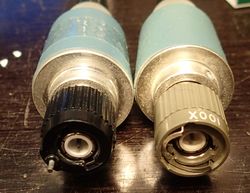BNC connector with readout ring: Difference between revisions
Jump to navigation
Jump to search
No edit summary |
(fixed now broken link to sci.electronics forum through wayback machine link) |
||
| Line 37: | Line 37: | ||
| ×500 || 690 Ω <ref name="eevblog" /> | | ×500 || 690 Ω <ref name="eevblog" /> | ||
|- | |- | ||
| ×1000 || 470 Ω <ref name="sciel">[https://www.electronics-related.com/sci.electronics.design/thread/116046/readout-pin-on-oscilloscope-probes.php sci.electronics.design thread (2009) about probe readout details]</ref> | | ×1000 || 470 Ω <ref name="sciel">[https://web.archive.org/web/20140731013321/https://www.electronics-related.com/sci.electronics.design/thread/116046/readout-pin-on-oscilloscope-probes.php sci.electronics.design thread (2009) about probe readout details]</ref> | ||
|- bgcolor="#F0FFF0" | |- bgcolor="#F0FFF0" | ||
| Identify || short | | Identify || short | ||
Revision as of 04:47, 27 March 2024



Many 1970s/1980s Tektronix scopes and plugins have rings around the BNC input sockets that allow the attenuation factor of attached probes to be detected by the scope.
The connector of compatible probes, e.g. P6056, includes a contact pin connecting this ring. A resistor connected to ground encodes the probe attenuation (s.b).
- In most 7000-series plug-ins, the ring interfaces with the readout system. The plug-in circuit uses the shift instructions in time slot 1 to implement the change of range.
If the probe includes an Identify switch at the tip, this connects the readout pin directly to ground, encoding the special IDENTIFY instruction in time slot 1. - Readout-less 5000-series plug-ins and a number of standalone scopes of the same era, e.g. many of the 400-series scopes such as 464, use the ring to detect a ×10 (but not a ×100) probe, and indicate the correct scale factor using front-panel lamps or LEDs. The 485 also uses the probe ring and utilizes a TEK custom IC 155-0076-00 and three LEDs to indicate ×1, ×10, and ×100 probes.
- 7000-series scopes only display ×1, ×10 and ×100 factors. 11K, TDS, 2400 and later recognize ×1000, ×2, ×5, ×200 and possibly other factors.
- The 7A14 plugin uses the same BNC connector with a ring but the ring serves a different purpose, which is to detect the difference between the P6021 and P6022 probes, and switching in appropriate gain and frequency compensation. The P6021 (or a 131-0750-00 adapter for the P6019) shorts this ring to ground, directly switching three relays connected to −15 V internally.
Resistor values
please add known nominal values where noted '(?)'
| Display | Resistance |
|---|---|
| ×1 | open |
| ×2 | 2.2 kΩ (?) [1] |
| ×5 | 1.8 kΩ (?) [1] |
| ×10 | 11 kΩ [2] |
| ×20 | 1.6 kΩ (?) [1] |
| ×50 | 1.14 kΩ [3] |
| ×100 | 6.8 kΩ [2] |
| ×200 | 910 Ω (?) [1] |
| ×500 | 690 Ω [3] |
| ×1000 | 470 Ω [1] |
| Identify | short |
References
- ↑ 1.0 1.1 1.2 1.3 1.4 sci.electronics.design thread (2009) about probe readout details
- ↑ 2.0 2.1 Tektronix P6056/P6057 Manual
- ↑ 3.0 3.1 Tek P5205 HV differential probe teardown @ EEVBLOG (with internal photos)